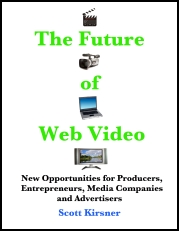 I’ve seen lots of year-end film lists, and even participated in some. What I haven’t seen, however, is a list of the top stories that matter to indie filmmakers. I wouldn’t say this is my definitive list, but it’s the top ten things that come to mind, in reverse order, along with New Year resolution suggestions.
I’ve seen lots of year-end film lists, and even participated in some. What I haven’t seen, however, is a list of the top stories that matter to indie filmmakers. I wouldn’t say this is my definitive list, but it’s the top ten things that come to mind, in reverse order, along with New Year resolution suggestions.10. Mermigas Firing proves Hollywood is still out of touch.
Diane Mermigas was the best writer in the film world. Who, you may be asking? Mermigas wrote a column on technology for the Hollywood Reporter - how it was disrupting business models and where things may be going. As most indie folks can’t afford the HR, very few may have read her column, but work picked up the tab for me, and I was a fan. Her last prediction - that Google might buy the NY Times (original) and she could be right. This only makes the top ten list because it would be like the Washington Post getting rid of Bob Woodward during Watergate – you don’t get rid of the one reporter that really knows what’s going on when your ship is sinking. Geeky blogs always thought she was old-fashioned (or worse), but she was the only columnist in film land who consistently understood the shifting landscape, and the Hollywood Reporter letting her go recently shows how out of touch old media remains about how the changes that are affecting them now are just the tip of the proverbial iceberg.
Resolution suggestion: Independent filmmakers should pay more attention to the geeky business news about the industry, because its going to affect your world as much as it will Hollywood, and you might just be able to use the changes to your advantage. Start with Mermigas’ old columns.
9. Orphan works proposals show there is some hope in copyright land.
An orphan work is one whose author can’t be found, even after extensive searching. In film, this usually affects documentaries that use rare footage, and with an orphan work, no one can authorize you as a filmmaker to use the footage in your film. Even though the rights-holder probably died years ago, no E&O Insurer will insure your film, and thus no one would distribute or broadcast it if it contained this footage. This year, a coalition of groups representing filmmakers (disclaimer: including the one I work for) made recommendations to the copyright office for a fair system to allow such works to be used, while maintaining safeguards for rights-holders. The proposal is now being considered by Congress, and could represent a nice change for filmmakers.
Resolution Suggestion: Click here to take action.
8. FCC acts indecent

Think that Janet Jackson’s breasts are unrelated to your issues as a filmmaker? Think again. Her exposure in the Super Bowl is just one example of the things that led the FCC to begin cracking down on things they consider “indecent.” Well, that and a bunch of right wing nuts, but the FCC’s actions have led PBS stations to not broadcast films due to fears of large fines, and while most of the films affected have been big (Saving Private Ryan, Ken Burns), this has huge implications for indie filmmakers. All broadcasters need is one more excuse to not show your unrated film.
Resolution suggestion: Marjorie Heins of the Free Expression Policy Project at NYU is leading the charge against this nonsense, and you should take an interest.

7. AIVF collapsed/Others Didn’t (yet?)
When AIVF started to go under, a group of us met to debate whether we cared. The consensus was, I think, that now more than ever, filmmakers needed a place like AIVF, but that the situation had deteriorated to the point that it couldn’t be salvaged. In early 2006, the board finally pulled the plug, and AIVF no longer exists. As I wrote then, the ideals of AIVF (it could no longer serve them) were still needed – in-depth information, advocacy, and a national community among the many needs. AIVF could have been the place to unite the UGC and Indie worlds and make a powerful lobby for creative concerns on the net; they could have been active in the recent debates about Showtime and the Smithsonian; they could have thrown a real awards for independent filmmakers (maybe in Brooklyn), when other awards shows departed from indies. On the plus side, my prediction that they were the first of many to go was either early or just wrong. IDA, IFP and others are surviving, IMAGE and Film Arts have new leaders and may rise from the (near) ashes. On the other hand, none seem to have taken the place of AIVF. Perhaps more will be clear when I moderate a panel on this subject at SXSW in March of 2007. (photo credit: Indiewire.com)
Resolution suggestion: Make your organization accountable by letting your voice be heard – let their executive directors know how you feel. Me included.

6. Fair Use gets a boost, and a manual
Fair Use is the legal concept that allows you to utilize copyrighted material, under certain conditions without asking for it. For example, Kirby Dick used this concept to make his recent doc This Film Is Not Yet Rated… because it allowed him to comment on the way the MPAA treated certain films, without having to pay large fees to show certain clips. For years, however, there was no clear system for filmmakers to follow in utilizing fair use, so Pat Aufderheide, a professor at American University and Peter Jaszi, a law professor, got together with filmmakers and their organizations (again, we participated) and crafted a Filmmakers guide to Fair Use. IFC used it in deciding to distribute Dick’s film, and rumor has it that Arthur Dong will be using the principles to release his new work The Chinese in Hollywood Project.
Resolution suggestion: Read the manual and stay informed via Agnes Varnum’s blog for the Center for Social Media.

5. New Distribution Models (and reminders of some old ones)
It still boggles the mind that anyone debates whether the windows model of releasing is a bad idea. Yes, Bubble didn’t work, but it’s clear to everyone that consumers want their media when they want it, where they want it, when they want it and on whatever device they want to see it on. The key will be versioning – having different versions, so that you can show one version at fests or theatres while the download is available, and possibly sell the extended (or educational) version later. While Holly/Indy-Wood distributors debated this, many simply threw up their hands in disgust and started their own distribution. Four Eyed Monsters showed the best way to use the internet to build buzz, Lance Weiler self-distributed to success and blogged about it, Sujewa focused his blog on self-distribution, Landmark made four-walling a little easier, and even David Lynch took to the streets to promote his own self-distribution (photo credit: Defamer.com). It was also fun to listen to filmmakers propose a self-distribution collective or system, when one already exists with New Day, and it was great to see filmmakers opening their eyes to the simple truth that getting a distributor can often be the worst thing that can happen to your film.
Resolution suggestion: Use fests to find an audience, instead of a distributor. Start here or here.
4. Death of VHS goes unnoticed

In November, Variety ran the obituary for VHS. Yes, you can still find them, but Hollywood and all but a handful of small distributors have abandoned them altogether. VHS lasted around 30 years, but no one expects DVD to last nearly that long. While people continue to debate whether consumers will switch to digital downloads or streaming, there are clear signs that DVD sales are slowing, and this has huge implications for indies. While every other technological advancement showed such promise in the past only to be closed down, we once again have the chance that indies can get their films to a wider audience through digital downloads, TiVO, Revver, or even through your Xbox. With the Long Tail model changing business, and with everyone from Amazon to Wal-Mart (I would go all the way to Z with Zune, but it’s such a bad player) getting in the digital download business, 2007 should be a interesting year.
Resolution suggestion: Read up about the implications with this report we produced, and check out your options for self-distribution online.
3. Google/Youtube and future implications

This one has been talked about enough online that I don’t need to add much more. Any way you look at it, however, it’s one of the most important media stories of 2006, with huge implications (still being sorted out) for distribution, copyright, revenue models for new media, etc. My hopes for 2007 – that independent filmmakers realize their kinship with the supposed amateurs of UGC, especially in regards to reaching audiences. This is about participatory culture and your audience finding your content more easily, not just finding videos of a frat boy falling down the stairs. You can use it to get people interested in your work, promote films you are trying to raise money for (advanced trailers) and to find your audience before your film is completed. Gootube is, of course, just one part of the story, but every filmmaker should be thinking about how to use online video to their advantage.
Resolution suggestion: Post teasers or trailers for all of your films online for free – even better, put a Creative Commons license on them, and read the book about your opportunities by Scott Kirsner.
2. Sundance Channel opens a Screening Room in Second Life
I’ve been suggesting for a long time that filmmakers need to get a presence in Second Life, and I wasn’t the only one. Recently, Sundance Channel announced they will launch a Second Life screening room and will premiere Four Eyed Monsters online in January of 2007. Second Life is a growing phenomenon, and people are making real money there. More importantly to filmmakers – it’s another place to find an audience for your work.
Resolution suggestion: I’m willing to bet that some media artists can make something more creative than some suits at Sundance Channel (okay, I know many people there who don’t wear suits), so get online, create an avatar and corner the market for cool visuals in Second Life.
1. Net Neutrality
Unfortunately, much of the above-mentioned promise for indies is threatened by the possible end of the internet as we know it. That’s what net neutrality means – saving the internet. I could go on and on about this, but many people have made great videos about it, like this one:

Resolution Suggestion: Educate yourself on Net Neutrality, get active in the debate and stop big media from ruining our possible future(s) online.
And Happy New Year!






